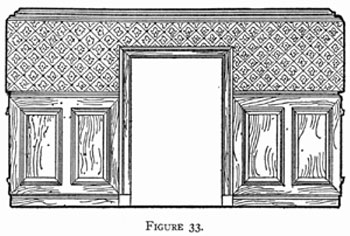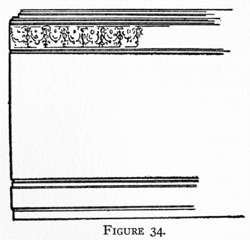Instinctive Insistance of a Dominant Element
Our instinctive insistence upon the presence of a dominant element in every composition conditions the proportions of all horizontal divisions of the wall spaces. When a wall is divided into two parts only, one part must be perceptibly wider than the other, and the more nearly these divisions approximate the ratio of five to three, other things being equal, the more pleasing they will be. Figure 33 shows a dining room wall in which this ratio appears in the proportions of the wall itself, in the division into paneling and frieze, and in the opening. This, of course, is not a law, but only a safe guide. In practice the horizontal division of a given wall space may vary widely from these proportions and still be entirely satisfactory, provided only that the mind is left in no doubt as to the presence of a dominant element. The ratio might also require to be modified to make allowance for the peculiar effect of the design of paneling or frieze. Thus vertical panels without any horizontal rails would increase the apparent height of the lower member, while a frieze designed upon marked horizontal lines or wide lateral curves would apparently diminish that of the upper member.

When, in the case of large and important rooms, there are three or more horizontal divisions, one must perceptibly exceed the total of all the others. The elevation shown in Figure 34, based upon the Tuscan order, has a height of ll'6", with a dado of 2'3", a sidewall of 7'2", a frieze of 1'6", and a 7" cornice. In the decoration of a given room these proportions will naturally be so adjusted as best to accord with the motive of the room, the character and projection of its trim, and the design and coloring of the frieze; but as a rough rule of practice we may, taking one-nineteenth of the ceiling height as a module, give the dado a height of four modules, the sidewall twelve or slightly less, the frieze two or slightly more, and the cornice one or slightly less.

Where there are no horizontal divisions other than the regular low baseboard and a cornice or picture molding at the ceiling the difference between the sidewall and the other two members is so great that the mind makes no attempt to compare them, but instead compares the total height of the room with the windows, which thus become the element to be given principality, and which ought accordingly to be longer than the total of the space above the windows plus the space below. Here the mind is in general best satisfied when the space below the window is about one-third of the height of the window itself, while the space above is about one-fourth of the length of the window. Thus a room with a ceiling nine feet and six inches high would look well with windows six feet long. having two feet from sill to floor, and one foot six inches from top of window to ceiling. It must, of course, be noted that these vague generalizations are not intended to apply to the design of great apartments, where the openings will start from the floor and be carried by means of over-door and over-window treatments to the cornice. They apply to rooms of ordinary size and proportions only, and then merely as suggestions which arc reasonably sure to lead to satisfactory results- Nothing could be more false than the assumption that relations of proportion can be reduced to unalterable formulas.
The beauty of proportion which is the principal element of that organic harmony characteristic of a well-furnished room depends first of all upon a proper emphasis of structure. In the perfect room we are always conscious of being indoors, not out. At the back of the mind lies always the intimate sense of shelter, of protection, of freedom to live our lives unhindered by nature or by man. This implies a sense of strong walls, of adequate coverings for the openings, above all of a firm roof over our heads. No room can be a perfect room unless it makes us subtly aware of the presence of these primary requirements of shelter.
The trim or woodwork of a room outlines its structure and helps to steady and support its decorative treatment. It is clear that the emphasis to be placed upon this structural outline will vary according to the character of the room and the way in which it is to be furnished, since anything large, heavy, elaborate or complex will require a stronger structural support than will anything small or light or simple. The effect of strength and importance of the woodwork will vary directly with the factors of area, projection, sharpness of outline, marked texture, and contrast with the wall areas.
 "Finally! Step-by-Step Guidebooks Show
"Finally! Step-by-Step Guidebooks Show